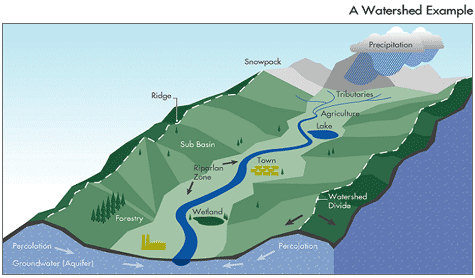 No matter where you live, you’re living in a watershed! A watershed is an area of land that is drained by a distinct stream or river system and is usually separated from other watersheds by the crest of hills or mountains. Also called a “catchment” or “drainage basin” a watershed can cover a large, multi-state area like the Columbia River watershed or a relatively small area, such as the Amazon Creek basin. Larger watersheds are made up of numerous smaller watersheds, which are then called sub-watersheds or sub-basins. For example, each of the main tributaries to the Long Tom River are sub-watersheds.
No matter where you live, you’re living in a watershed! A watershed is an area of land that is drained by a distinct stream or river system and is usually separated from other watersheds by the crest of hills or mountains. Also called a “catchment” or “drainage basin” a watershed can cover a large, multi-state area like the Columbia River watershed or a relatively small area, such as the Amazon Creek basin. Larger watersheds are made up of numerous smaller watersheds, which are then called sub-watersheds or sub-basins. For example, each of the main tributaries to the Long Tom River are sub-watersheds.
Watersheds have many landscape types, including upland areas extending from ridge tops down to streamside areas which include wetlands, lakes, streams, and rivers. In a well-functioning watershed, vegetation and wetlands intercept falling rain (and snow), slow the flow of that water as it moves through the stream system, remove pollutants, and allow the water to percolate into the ground to recharge groundwater. This creates clean water and natural stream filtration which provides habitat for fish and wildlife.
